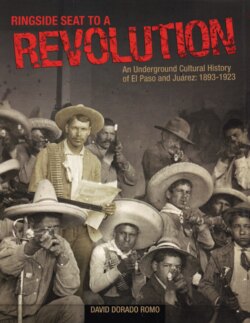Читать книгу Ringside Seat to a Revolution - David Dorado Romo - Страница 44
На сайте Литреса книга снята с продажи.
Оглавлениеbeen written about her in the past. Teresita may have been a pacifist during her Mexican period, but by the time she
reached El Paso she was no longer the same woman. It appears that the massacre of Tomóchic radicalized her, like
it did many other fronterizos. There are just too many firsthand accounts—from many different sources—about her
underground activities in support of the revolution. It could be that they’re mostly just rumors, puro chisme. But those
historians who completely excise this chisme—this underground vox popoli—from their accounts of the past leave
out an important part of the picture. Sometimes the made-up, the imagined and the exaggerated, impact historical
developments just as much as the facts do. Sometimes even more.
With Teresita Urrea, fact and rumor often blend into one. I’ve explored the zones where Teresita left her mark
behind as carefully as I could, but I must admit that I can’t always distinguish clearly between the two. At the risk of
life, limb and incurring the wrath of the Yaquis, I’ve given it my best shot.
39
✯ ✯ ✯
ON AUGUST 12, 1896, 40 rebels attacked the cus-
tomshouse in Nogales, Sonora shouting “¡Viva la
Santa de Cabora!”80
The Teresista rebels killed two Mexican federal
soldiers and briefly took over the customhouse.
About 150 American militiamen from Arizona crossed
the border into Mexico. Together with a band of
rurales—the mounted Mexican rural police force—
they dislodged the Teresistas from the customhouse
after engaging them for several hours. Many of the
revolutionists fled to the mountains or back to the
United States where the raid had been organized.81
As a deterrent for future revolutionaries, the bul-
let-ridden bodies of seven rebels (most of them
Yaquis) killed in the firefight were laid down on the
sidewalk for all to see. Some of them carried letters
signed by Teresita or photographs of her hung
around their neck. Others carried copies of El
Independiente, which listed Teresita and Lauro
Aguirre as coeditors.
Five days after the Nogales raid, Demetrio Cortez
led an attack on Ojinaga with 19 Teresista rebels. It
was repulsed by a civilian militia from nearby.
Rumors had it that a woman claiming to be Teresita
had been in Ojinaga, months before, preparing the
uprising. Supposedly, she collected between $2,000
to $3,000 for the revolution from her followers.82
A month after the Ojinaga raid, 50 armed men
under the leadership of Pomposo Ramos Rojo and
Prisciliano Silva attacked Palomas—the Mexican town
opposite Columbus, New Mexico—with similarly
unsuccessful results. (A decade later, Prisciliano Silva
would become one of the major military leaders of
the anarchists in El Paso.)
Throughout September, government troops in
Juárez were in a state of heightened alert, if not near
panic, fearing that they would soon be attacked by
200 Teresistas. On the night of September 10th, 100
Mexican rurales patrolled the river. The 19th infantry
slept on their arms at the Juárez garrison. Employees
of the Ketelsen & Degetau store kept watch all night
on the rooftop armed with rifles. (The hardware and
ammunition store, owned by Jewish-German immi-
grants, would be blown up by Pancho Villa during
the 1911 Battle of Juárez.) The nervous Juárez troops
shot and mortally wounded a Mexican man walking
near the Rio Grande who didn’t stop when the sol-
diers ordered him to halt.
The Teresista attack on Juárez never took place.
But a few days after the false alarm, Las Cruces
Sheriff Pat Garrett—who was famous for gunning
down Billy the Kid—sent reports to the El Paso
authorities that a “well-armed and mounted” group
of about 75 men had been seen near Rincon, New
Mexico, heading toward the border. The authorities
arrested Demetrio Cortez and two other men riding
80
They were led by a Manuel González, whom the press claimed was a survivor of the Tomóchic uprising, and the Mexican American Benigno
Arvizu, who had collaborated with Victor L. Ochoa during a series of uprisings in 1893.
81
El Paso Times, August 14, 1896. The Arizona militiamen later argued that they had been misled by the Mexican Consul to believe that the attack-
ers were armed robbers and not revolutionaries. The American officials had helped the Mexican officials ward off bandits in the past. But the
U.S. officials were concerned that helping to fight off political revolutionaries could be considered meddling in the internal affairs of Mexico.
Despite this disclaimer, American participation on this occasion would be just one of many incidents in which Americans would violate Mexico’s
territorial integrity to subdue political rebels.
82
Vanderwood, The Power of God, p. 296.
